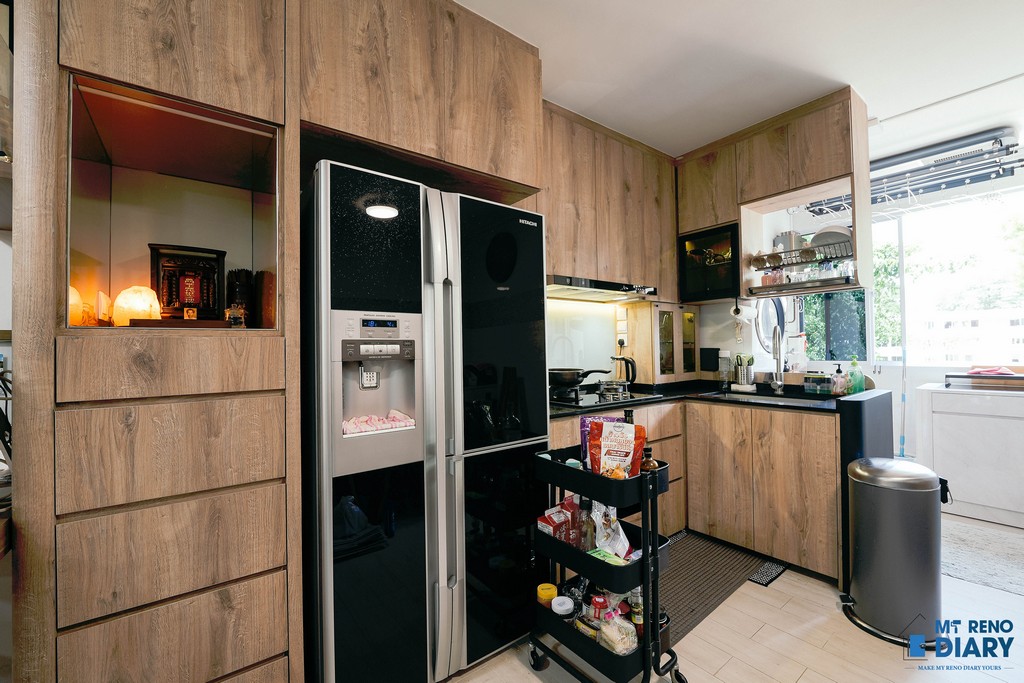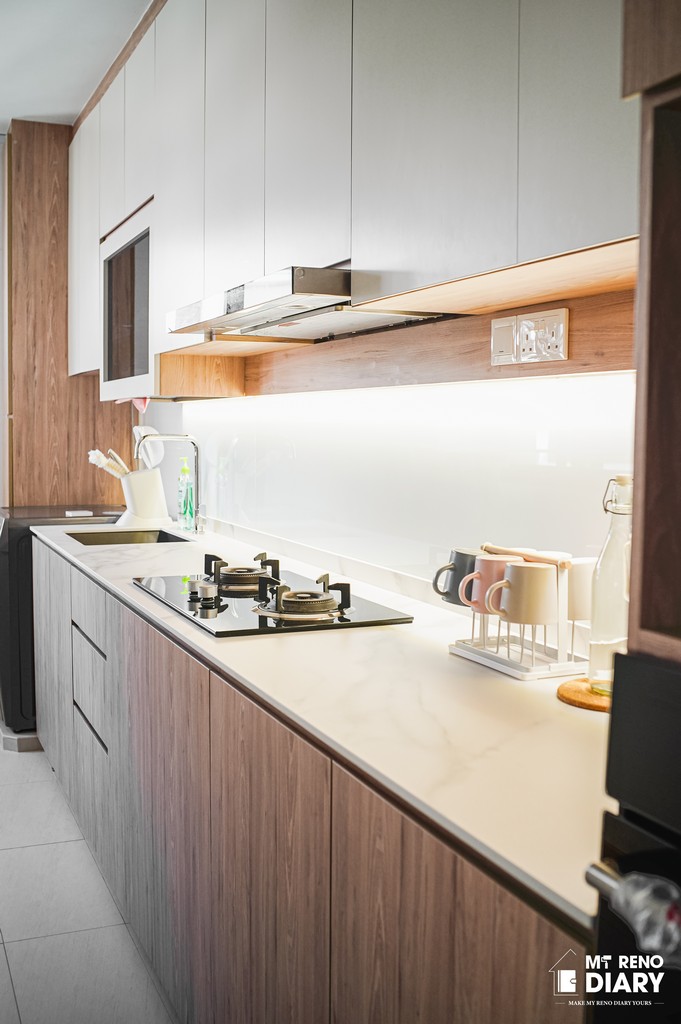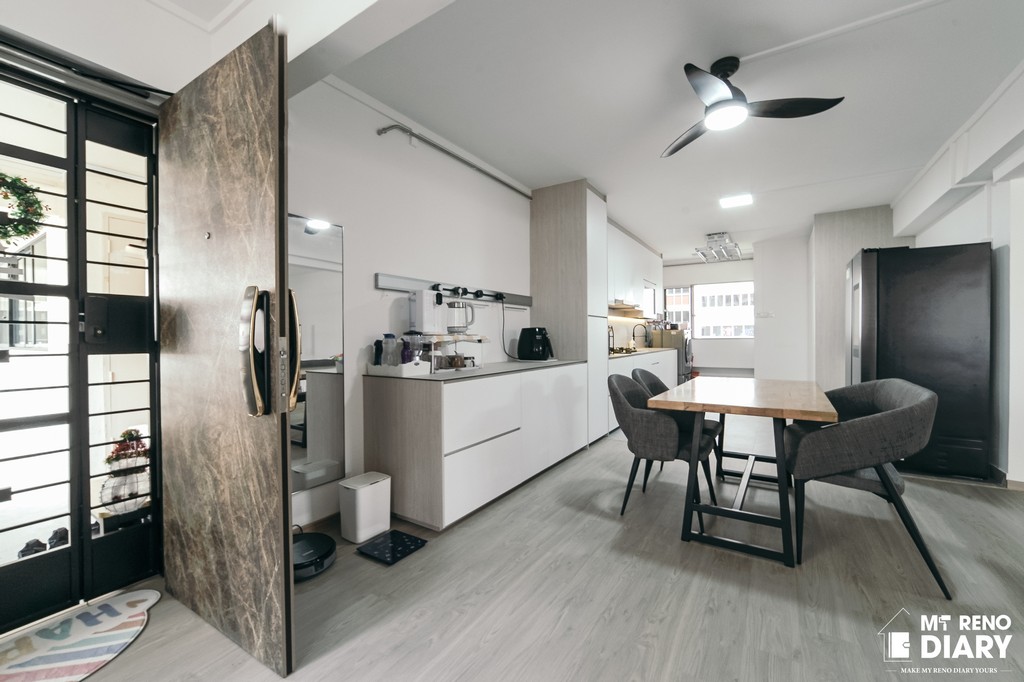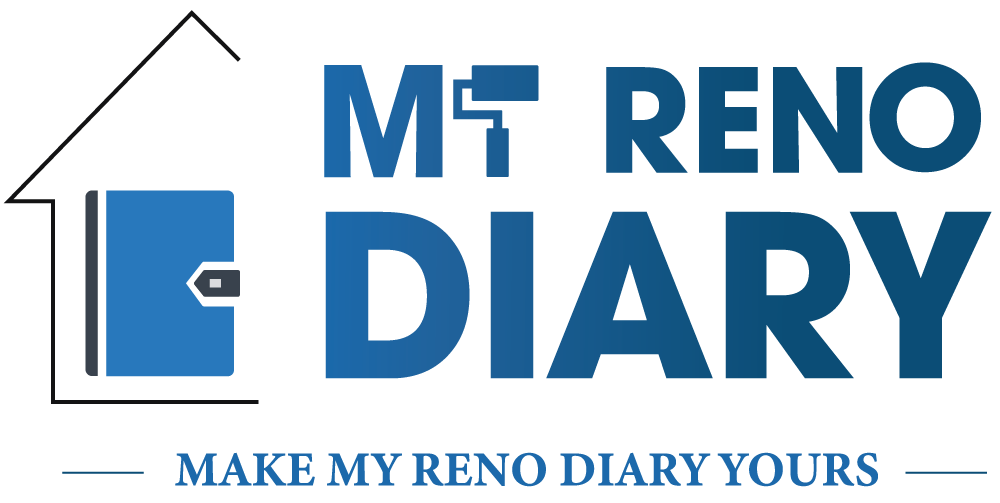Are you ready to turn your HDB kitchen into the heart of your home? Whether you’re dreaming of a modern and functional space or looking to incorporate the latest design trends, our comprehensive guide has got you covered. From layout planning to material selection, we’ll walk you through every step of the kitchen design process. So, how can you create a kitchen that not only meets your needs but also reflects your style and personality? Let’s dive in and discover the secrets to designing your dream HDB kitchen.

The Heart of the Home
A well-designed kitchen is the heart of every home, serving as a space for cooking, dining, and gathering with loved ones. It is the central hub where families and friends come together to share meals, create memories, and enjoy each other’s company. The kitchen is not just a functional space, but also a reflection of your personal style and taste.
Understanding the importance of a well-designed kitchen goes beyond aesthetics. It is about creating a space that caters to your specific needs and enhances your daily living experience. A thoughtfully designed kitchen can improve the functionality, efficiency, and organization of your culinary tasks. Whether you are an avid cook or enjoy casual meals, having a functional kitchen design can make your everyday life easier and more enjoyable.
When embarking on your HDB kitchen design project, it is essential to identify your goals and priorities. Consider the specific needs and requirements of your household to create a kitchen that aligns with your lifestyle. Some common goals for kitchen remodeling ideas may include:
- Creating a functional workspace: Designing a layout that maximizes efficiency and ease of use for food preparation and cooking.
- Maximizing storage: Incorporating clever storage solutions to make the most of limited HDB kitchen space.
- Incorporating a specific style: Infusing your kitchen with a design theme or aesthetic that reflects your personality and complements the overall interior design of your home.
By setting clear goals for your HDB kitchen design project, you can focus your efforts and make informed decisions throughout the process. With a well-defined vision in mind, you can collaborate effectively with interior designers or contractors and ensure that your kitchen design meets your expectations and requirements.
Just a comment:
A “functional kitchen layout” can support the goal of creating a functional workspace.
| Kitchen Remodeling Ideas | Functional Kitchen Design |
|---|---|
| Maximize storage with innovative solutions | Create a layout that optimizes workflow |
| Incorporate space-saving features | Choose durable materials for countertops and backsplash |
| Integrate modern appliances for efficiency | Consider lighting design to enhance ambiance |
| Personalize your kitchen with unique touches | Strategically plan for accessible storage |
| Keep aesthetics in mind while selecting materials and color schemes | Prioritize functionality without compromising on style |

Mastering the Layout of Your HDB Kitchen
When it comes to designing your HDB kitchen, the layout is a key factor that can make or break its functionality and flow. To achieve a modern kitchen layout that optimizes every inch of space, you need to analyze your kitchen’s limitations and potential.
Analyzing Your Space: Effective Layout Planning
Start by carefully assessing the available space in your HDB kitchen. Consider the dimensions, architectural features, and existing utilities. Take note of any structural constraints such as walls, windows, or pillars that could impact the layout.
Next, identify the primary work areas in your kitchen, such as the cooking zone, preparation area, and storage space. Determine how you want these various zones to interact with each other, keeping in mind the flow of movement and ease of access.
With this information in hand, you can now embark on effective layout planning. The goal is to create a functional kitchen layout that optimizes space and facilitates effortless workflow. Consider different layout designs, such as:
- U-shaped layout: Ideal for larger kitchen spaces, this layout provides ample countertop area and storage while ensuring easy access to all work zones.
- L-shaped layout: This popular layout works well for smaller HDB kitchens, maximizing corner space and allowing for efficient workflow.
- Galley layout: Perfect for narrow kitchens, this layout features two parallel counters, creating a streamlined workflow from one end to the other.
Explore these options and assess which one suits your space and needs the best. Remember to prioritize functionality and ensure that the layout allows for smooth movement and accessibility of essential kitchen features.
By mastering the layout of your HDB kitchen, you can create a space that not only looks modern and stylish but also functions seamlessly, maximizing the potential of your kitchen area.
Smart Storage Solutions for HDB Kitchens
HDB kitchens often pose a challenge with limited space. However, with smart storage solutions, you can maximize every inch of your kitchen and create a clutter-free and functional space. In this section, we will explore innovative ideas for space-saving kitchen designs, custom kitchen cabinets, and storage solutions that will help you make the most of your HDB kitchen.
Maximizing Space with Innovative Storage Ideas
To optimize your HDB kitchen’s storage capacity, consider incorporating these innovative storage ideas:
- Pull-out drawers: Install pull-out drawers in your kitchen cabinets to easily access items at the back without bending or reaching.
- Corner cabinets: Utilize corner spaces by installing corner cabinets with rotating shelves or pull-out trays to maximize storage space.
- Vertical storage solutions: Take advantage of vertical space by installing wall-mounted racks, shelves, or hooks to store pots, pans, and utensils.
- Under-cabinet storage: Install hooks or magnetic strips underneath your cabinets to hang mugs, cooking tools, and other lightweight items.
- Overhead storage: Use the space above your cabinets or kitchen island for additional storage by installing floating shelves or hanging baskets.
Custom Cabinetry and Shelving Solutions
Custom kitchen cabinets and shelving offer tailored storage options to suit your specific needs. Consider these possibilities:
- Customized cabinet compartments: Design cabinets with special compartments for appliances, cutting boards, and utensils, keeping everything neatly organized.
- Built-in spice racks: Optimize your cabinet space by incorporating built-in spice racks to keep your spices organized and easily accessible.
- Open shelving: Install open shelves to showcase your favorite kitchenware and create a visually appealing display while keeping frequently used items within reach.
- Hidden storage solutions: Incorporate hidden storage compartments, such as concealed roll-out pantries or toe-kick drawers, to maximize space without sacrificing aesthetics.
- Customized shelving units: Design shelving units that fit perfectly in your kitchen to make efficient use of every available space, including gaps between appliances or walls.
By implementing these smart storage solutions and custom cabinetry options in your HDB kitchen, you can transform it into a well-organized and efficient space that meets all your storage needs.
| Storage Solution | Description |
|---|---|
| Pull-out drawers | Accessible storage option installed in cabinets, allowing easy retrieval of items. |
| Corner cabinets | Cabinets specifically designed for corner spaces to maximize storage capacity. |
| Vertical storage solutions | Utilizing vertical wall space by installing racks, shelves, or hooks to store kitchen items. |
| Under-cabinet storage | Utilizing the space underneath cabinets for hanging lightweight items. |
| Overhead storage | Using the space above cabinets or kitchen island for additional storage. |
| Customized cabinet compartments | Designing cabinets with specialized compartments for specific kitchen items. |
| Built-in spice racks | Incorporating built-in racks for organizing and accessing spices. |
| Open shelving | Installing shelves for displaying kitchenware and keeping frequently used items within reach. |
| Hidden storage solutions | Including concealed compartments like roll-out pantries or toe-kick drawers for hidden storage. |
| Customized shelving units | Designing shelving units that perfectly fit your kitchen space, utilizing every available gap. |

Choosing Appliances That Fit Your Space and Needs
When designing your HDB kitchen, it’s essential to select appliances that are appropriately sized for your space. By choosing appliances that fit your space and needs, you can maximize functionality and optimize the available space in your kitchen. In this section, we’ll explore space-saving and efficient appliance selection and the benefits of integrating appliances for a seamless look.
Space-Saving and Efficient Appliance Selection
In a small HDB kitchen, every inch of space is valuable. It’s crucial to choose appliances that are compact and designed to save space while still providing the functionality you need. Consider incorporating the following space-saving appliances into your kitchen design:
- Slim refrigerators: These narrow refrigerators are perfect for small kitchens where space is limited. They offer ample storage while taking up minimal floor space.
- Built-in microwaves: A built-in microwave can be installed above your countertop or integrated into your kitchen cabinetry, freeing up valuable counter space.
- Induction cooktops: Induction cooktops are not only energy-efficient but also take up less space compared to traditional gas or electric cooktops.
- Compact dishwashers: If you prefer the convenience of a dishwasher, there are compact options available that can easily fit into smaller kitchens.
By opting for space-saving appliances, you can create a more functional kitchen without sacrificing valuable countertop or storage space in your HDB flat. Remember to consider the specific needs and requirements of your household when selecting appliances.
Integrating Appliances for a Seamless Look
Another way to optimize the design of your HDB kitchen is by integrating appliances for a seamless and cohesive look. Hiding appliances behind cabinet panels or integrating them into the overall cabinetry design can create a streamlined aesthetic. This approach works especially well for appliances like dishwashers or refrigerators.
Integrating appliances not only contributes to a more visually appealing kitchen but also helps maintain a sense of continuity and flow. By blending appliances into the overall design, you can create a cohesive and harmonious space.
If you’re considering integrating appliances, work with a professional kitchen cabinet Singapore supplier or designer who can assist you in selecting the right appliances and advise on how to seamlessly incorporate them into your kitchen design.
Now that we’ve explored the importance of choosing appliances that fit your space and needs, let’s move on to the next section, where we’ll delve into the selection of materials and colors for your HDB kitchen.
Material and Color Selection for Aesthetic Appeal
When designing your HDB kitchen, selecting the right materials and color schemes is essential for creating an aesthetically appealing space. By carefully choosing durable and stylish materials for your countertops and backsplash, you can achieve both durability and style in your kitchen.
Countertop and Backsplash Materials for Durability and Style
Quartz and porcelain tiles are popular choices for countertops and backsplashes in modern kitchen design. Quartz is known for its durability, resistance to stains and scratches, and ease of maintenance. It is available in a wide range of colors and patterns, allowing you to find the perfect match for your kitchen’s aesthetic. Porcelain tiles, on the other hand, offer versatility in design with various finishes, sizes, and shapes. They are highly durable, heat resistant, and easy to clean, making them ideal for kitchen surfaces.
| Material | Durability | Style |
|---|---|---|
| Quartz | High | Wide range of colors and patterns |
| Porcelain Tiles | High | Versatile finishes, sizes, and shapes |
Color Schemes That Enliven Your Kitchen Space
The color scheme you choose for your kitchen can greatly impact its overall look and feel. Contemporary kitchen trends often include a mix of neutral tones and bold, vibrant colors. Neutral tones such as white, gray, and beige create a timeless and sophisticated look, while bold and vibrant colors like blue, green, or red can add a pop of personality and energy to the space. Consider incorporating contrasting colors for your kitchen cabinets, walls, and accessories to create a visually pleasing and dynamic atmosphere.
- Neutral tones: white, gray, beige
- Bold and vibrant colors: blue, green, red
- Contrasting color combinations
By staying updated on the latest contemporary kitchen trends, you can ensure that your kitchen design reflects modern aesthetics and creates a visually appealing space.
Lighting Design to Enhance Your Kitchen’s Ambiance
The Role of Lighting in Kitchen Design
One of the key elements in creating a functional and beautiful kitchen is lighting design. Lighting not only illuminates the space but also sets the overall ambiance and mood. Properly planned and executed lighting can enhance the functionality and aesthetics of your kitchen, making it a pleasant and inviting space.
Selecting Fixtures for Task and Mood Lighting
When it comes to kitchen lighting, it’s important to consider both task lighting and mood lighting. Task lighting focuses on providing adequate illumination for specific activities, such as food preparation and cooking. This type of lighting ensures that you have sufficient brightness in areas where you need it the most.
Mood lighting, on the other hand, creates a warm and cozy atmosphere in the kitchen, making it an inviting space for gatherings and relaxation. It can be achieved by using dimmable lights, installing pendant lights above the dining area, or incorporating under-cabinet lighting to highlight certain features.
Choosing the right fixtures for task and mood lighting is crucial. Consider the following factors when selecting lighting fixtures for your kitchen:
- The size and layout of your kitchen
- The style and theme of your kitchen design
- The brightness and color temperature of the lights
- The energy efficiency and durability of the fixtures
Working with professional kitchen interior designers can help you make informed decisions about lighting fixtures that will not only enhance the functionality of your kitchen but also complement its overall design aesthetic.
| Task Lighting | Mood Lighting |
|---|---|
| – Under-cabinet lights | – Dimmable lights |
| – Pendant lights above work areas | – Chandeliers or decorative ceiling lights |
| – Recessed lights directly above countertops | – Table lamps or floor lamps |
| – LED strip lights inside cabinets | – Wall sconces |
Table: Lighting Fixture Ideas for Task and Mood Lighting in Your Kitchen
By carefully considering your lighting needs and selecting the right fixtures, you can create a kitchen that is both functional and inviting. The interplay of task lighting and mood lighting will not only enhance your culinary experience but also contribute to the overall ambiance of your kitchen space.

Incorporating Design Inspirations and Trends
Keeping Your Kitchen Design Timeless Yet Trendy
The key to creating a stunning kitchen design is finding a balance between timeless elements and current trends. By combining classic design features with contemporary touches, you can achieve a kitchen that stands the test of time while still embracing the latest styles. Here are some tips to help you keep your kitchen design both timeless and trendy:
Design Inspirations for Your Kitchen Theme
When it comes to designing your kitchen, finding the right theme can provide a strong foundation for your overall design. Consider exploring different design inspirations that align with your personal style and preferences. Here are a few popular kitchen themes to consider:
- Scandinavian: Emphasizing simplicity, clean lines, and natural elements, a Scandinavian-inspired kitchen can create a bright and airy space.
- Industrial: Incorporating raw materials, exposed brickwork, and sleek metal finishes, an industrial-themed kitchen can exude a modern and urban vibe.
- Minimalist: With a focus on simplicity and minimal clutter, a minimalist kitchen design can create a sleek and sophisticated space.
Keep in mind that these are just a few examples, and you can always mix and match elements to create a unique kitchen theme that reflects your personal taste.
Getting Ideas from Renowned Kitchen Interior Designers
Looking for inspiration from renowned kitchen interior designers can provide valuable insights into the latest trends and design techniques. Explore online platforms and publications that showcase the works of top designers in the industry. Look for elements that resonate with your vision and incorporate them into your own kitchen design. Remember, the goal is not to replicate the exact design, but to draw ideas and inspiration to make your kitchen truly unique.
By keeping your kitchen design timeless yet trendy and seeking inspiration from various sources, you can create a kitchen that perfectly reflects your style and stays relevant for years to come.
Sustainable Practices in Kitchen Design
Creating a sustainable kitchen is not only good for the environment but also contributes to a healthier and more eco-friendly home. By incorporating eco-friendly materials and making conscious choices in your kitchen design, you can reduce your carbon footprint and create a space that promotes sustainability. Here are some tips for incorporating sustainable practices in your kitchen design:
Eco-Friendly Materials and Appliances
One of the key elements of sustainable kitchen design is choosing eco-friendly materials. Consider using bamboo or reclaimed wood for your kitchen cabinets and flooring. These materials are renewable and have a lower impact on the environment compared to traditional hardwoods. Additionally, opt for countertops made from recycled materials or natural stone options like quartz, which is durable and long-lasting.
When selecting appliances for your kitchen, look for energy-efficient models that have high Energy Star ratings. These appliances are designed to consume less energy, resulting in reduced utility bills and a smaller carbon footprint. Energy-efficient appliances not only help you save money in the long run but also contribute to a greener planet.
Tips for Reducing Waste and Conserving Energy
In addition to choosing eco-friendly materials and appliances, there are several practical tips you can follow to further reduce waste and conserve energy in your kitchen:
- Practice composting: Set up a compost bin in your kitchen to dispose of organic waste, such as vegetable peels and coffee grounds. Composting reduces the amount of waste that goes to landfills and provides nutrient-rich soil for your plants or garden.
- Use reusable containers: Instead of relying on single-use plastic containers and bags, opt for reusable alternatives. Invest in glass or stainless steel food storage containers and reusable shopping bags to minimize waste.
- Switch to LED lighting: Replace traditional incandescent bulbs with energy-efficient LED lights. LED lights have a longer lifespan and consume less energy, contributing to significant energy savings over time.
- Install water-saving fixtures: Choose faucets and showerheads that are designed to conserve water. These fixtures reduce water consumption without compromising on functionality and performance.
- Optimize natural lighting: Make the most of natural light by strategically placing windows or skylights in your kitchen. Natural lighting reduces the need for artificial lighting during the day, saving energy and creating a pleasant ambiance.
By implementing these sustainable practices, you can create a kitchen that is not only visually appealing but also environmentally responsible. From utilizing eco-friendly materials to adopting energy-saving habits, a sustainable kitchen design allows you to enjoy a functional and beautiful space while minimizing your ecological footprint.
| Benefits of Sustainable Kitchen Design |
|---|
| Reduces carbon footprint |
| Contributes to a healthier home environment |
| Promotes long-term cost savings through energy efficiency |
| Minimizes waste and encourages recycling |
| Creates a visually appealing kitchen space |
Overcoming Design Challenges in Small Kitchens
Small HDB kitchens present unique design challenges that can be overcome with thoughtful solutions. When working with limited space, it’s crucial to maximize every inch and create a functional and efficient kitchen. Here are some practical ideas to help you overcome common spatial constraints and make the most of your small kitchen:
Solutions for Common Spatial Constraints
1. Optimize storage: Utilize vertical space by installing tall cabinets or shelves that reach the ceiling. Consider using pull-out drawers and organizers to efficiently store pots, pans, and utensils. Use hooks or magnetic strips to hang frequently used tools and knives, saving valuable counter space.
2. Utilize corners: Corners are often wasted space in small kitchens. Make use of corner cabinets with carousel or lazy susan mechanisms to easily access items stored in the corners. Alternatively, install open shelves or floating corner shelves to display decorative items or store frequently used ingredients.
3. Streamline the workspace: Make your kitchen feel more spacious by keeping countertops clutter-free. Store small appliances and utensils in cabinets or drawers to maintain a clean and organized look. Consider using multi-functional appliances or compact versions to save space.
Creative Ideas for Expanding Your Kitchen’s Capabilities
1. Add a kitchen island: If space allows, consider adding a kitchen island to increase counter and storage space. Choose a design with built-in cabinets and shelves to maximize its functionality. This will also create a designated area for meal preparation and additional seating if you opt for an island with a breakfast bar.
2. Incorporate multi-functional furniture: Look for furniture pieces that serve dual purposes to maximize space. For example, consider a dining table that doubles as a workspace or a kitchen cart with built-in storage that can be moved around as needed.
3. Embrace open shelving: Open shelves can create an illusion of space while offering storage and display opportunities. Install them above countertops or around range hoods to keep frequently used items within reach and add an element of visual interest to your kitchen.
By implementing these solutions and embracing creative ideas, you can transform your small HDB kitchen into a functional and stylish space. Remember, it’s all about maximizing every inch and finding innovative ways to optimize storage and workspace.
Real-Life HDB Kitchen Transformations
Embark on a visual journey through inspiring real-life HDB kitchen transformations. Witness the remarkable before and after changes that homeowners have achieved, showcasing the power of a well-executed renovation. From outdated and cramped spaces to modern and functional kitchens, these transformations will leave you motivated and excited to renovate your own HDB kitchen.
Before and After: Showcasing Kitchen Makeovers
Experience the transformative power of kitchen remodeling ideas as we present a collection of before and after photos. Witness how clever layout designs, smart storage solutions, and carefully chosen materials can completely revamp an HDB kitchen. Get inspired as you see the astonishing results achieved by homeowners who took on the challenge of renovating their kitchens.
Insights and Advice from Homeowners
Learn from those who have successfully navigated the process of HDB kitchen renovation. Gain valuable insights and advice from homeowners who share their experiences, tips, and lessons learned. Discover the challenges they faced and how they overcame them, as well as the key decisions that led to the success of their kitchen transformations. With their firsthand knowledge, you’ll be equipped with the wisdom needed to embark on your own renovation journey with confidence.
Crafting Your Dream HDB Kitchen
Designing your dream HDB kitchen is an exciting journey filled with endless possibilities. Throughout this comprehensive guide, we have covered the essential steps and considerations to help you transform your HDB kitchen into a functional and beautiful space that suits your lifestyle.
Summarizing Key Takeaways for Kitchen Design Success
As you embark on your kitchen design project, remember the importance of careful planning and layout. Analyze your space and select a layout design that maximizes functionality and flow. Consider incorporating smart storage solutions to make the most of limited space and choose appliances that are appropriately sized for your kitchen.
Material and color selection play a significant role in creating an aesthetically pleasing kitchen. Choose durable materials for your countertops and backsplash and explore different color schemes to enliven your space. Lighting design is another crucial element that enhances your kitchen’s ambiance.
The Journey Toward a Functional and Beautiful Kitchen
Whether you have a strict budget or are looking for luxurious finishes, creating your dream HDB kitchen is achievable. Remember that the journey toward a functional and beautiful kitchen is not just about the end result but also the process itself. Embrace your creativity, seek inspiration from design trends, and don’t be afraid to personalize your space.
Now that you have gained valuable insights and practical tips from experienced homeowners, it’s time to embark on your own kitchen design project. With passion, confidence, and attention to detail, you can craft a dream HDB kitchen that reflects your unique style and enhances your daily life.


